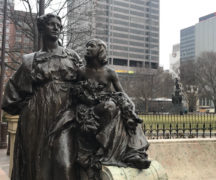Ohio Capital Journal
The star of Ohio Department of Health Director Dr. Amy Acton continues to rise during the coronavirus pandemic as she has established herself among the most insightful, reassuring and trustworthy voices for Ohioans in this unsettling time.
Acton is the calm-yet-determined highlight of Gov. Mike DeWine’s daily 2 p.m. news briefings, which have themselves become somewhat of an Ohio cultural event. Stores are selling “Wine with DeWine: It’s 2 o’clock somewhere” t-shirts. There’s also an entertaining viral video of the pair playing on the Laverne & Shirley opening theme song.
As we’ve been covering COVID-19 in Appalachia this week, the rising star of Dr. Acton puts me in mind of another Ohio doctor who established himself as a leading physician, saving lives in the Ohio River settlements of Belpre and Marietta during the bilious fever epidemic in the summer of 1807: Dr. Samuel Hildreth.
Bilious fever is an antiquated medical diagnosis associated with excessive bile or bilirubin in the blood stream and tissues, causing jaundice — a yellow color in the skin or eyes and an orange color in the urine. This particular epidemic in 1807 is now thought to have likely been malaria or a form of influenza.
Hildreth, who grew up in Massachusetts the son of a prominent Revolutionary War physician, moved to Ohio in December 1806 at the age of 23, reaching the settlement of Marietta just in time to see Harman Blennerhassett leave his Ohio River island paradise on his ill-fated expedition with former Vice President Aaron Burr.
What kind of impact did Hildreth have? Nearly a century later, in a book on the history of Marietta and Washington County published in 1902 by Seymour J. Hathaway, Hildreth is introduced thusly: “No preface is necessary in an outline of the life of Dr. Samuel P. Hildreth. The reader already knows him.”
That book described the fever ripping through the Ohio river valley and Hildreth’s success in treating it.
“The epidemic which raged all along the Ohio was particularly severe in the neighborhood of Marietta. Few families at Belpre escaped. Dr. Hildreth was particularly fortunate in his treatment of these cases.”
At Belpre, Hildreth was required to go through arduous horseback riding from house to house across distances to treat various patients, Hathaway’s book describes, working his way through a resulting inflamed hip injury.
“The epidemic of 1807 furnished him the subject for a paper in the 10th volume of the New York Medical Repository,” Hathaway wrote. “From this time, he became known as an acute, discerning investigator and faithful writer on scientific and historic subjects.”
More than a century after Hathaway’s treatment of Hildreth, historian David McCullough highlighted the Ohio river valley doctor’s success in his 2019 work on the first settlement of the Northwest Territory at Marietta, The Pioneers.
“Town property as well as farms sunk in value. A stop was put to improvements in buildings, and Marietta, the oldest town in the state, retrograded as fast as it had ever advanced,” Hildreth wrote of the epidemic of 1807, according to McCullough.
McCullough highlighted how Hildreth often traveled 20 or 30 miles on horseback to make house calls to rescue a member of a distressed family “from the grasp of death,” treating more than 100 cases in Belpre.
The symptoms of the disease included pain in the head, bad taste in the mouth, pain in the back, followed by fever attended with delirium, as Hildreth described.
The death toll in Marietta was more than had ever been known, McCullough wrote, with nary a family untouched by the epidemic. Even for those without the disease personally, the grief over the loss of family and friends was dreadful. More than 60 men, women, and children died in the Marietta settlement with a population of around 400 at the time.
Where Hildreth was working in Belpre, 15 miles down river, out of 100 cases he was treating, only two or three people died, McCullough wrote.
“His reputation soared,” according to McCullough.
Subsequently, during 1810 and 1811, Hildreth served in the Ohio legislature. He also served on the Ohio Geologic Survey. Hildreth was noted as one of the first pioneers of science in the country west of the Alleghany Mountains. He died in Marietta on July 24, 1863 and was buried at Mound Cemetery in Marietta.
***
More Appalachia coverage from Ohio Capital Journal:
COVID-19 in Appalachia: Communities coming together while staying apart
Scott Hagan makes his living on the scaffold.
With a paintbrush in hand, he works on top of a platform given to him by a fellow Appalachian artist named Harley Warrick, the man who once painted thousands of Mail Pouch barns throughout the Midwest.
When the “Barn Artist” is not working outside, Hagan is usually lending his talents to school districts in the region. He wrapped up his latest project a few weeks ago at the appropriately-named Barnesville Middle School in his native Belmont County.
The majestic lunchroom tableau features a space launch, a depiction of the World War II flag raising at Iwo Jima, and a stunning recreation of Mount Rushmore. It looks great, but there’s just one problem: the entire school is empty.
All Hagan can do is hope the kids return later this year to see it. READ MORE
Dark Web: Telemedicine a challenge with lack of access in Appalachian communities
Ohio’s governor has expanded the state’s ability to use telemedicine during the coronavirus stay-at-home order, but for some parts of the state, that option isn’t available.
Rural areas like Southeast Ohio have had problems getting connected to reliable and affordable broadband service for years, to the point where a summit came together in 2017 in Washington County to discuss the issue.
But places like Meigs County still have to prioritize their use when they can access the internet, so the idea of adding a doctor’s appointment to their bandwidth doesn’t seem likely. READ MORE





